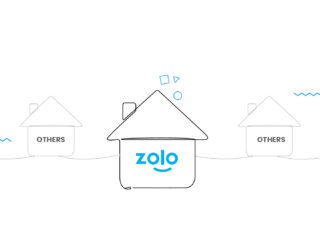Table of Contents

Exploring living arrangements, like coliving, used to be quite a history. But times have changed, bringing welcome relief from the hassles of dealing with landlords. Gone are the days of feeling overwhelmed by the daunting task of finding a new home. If you’re intrigued by coliving and weighing it as an option, discover the myths about coliving. While scepticism initially surrounded the Coliving concept, it has since become a multi-billion-dollar industry. In this article, we aim to debunk the most common myths surrounding coliving and illuminate the truth behind this innovative living arrangement.
Zolostays emerges as India’s foremost Coliving platform, presenting a seamless solution tailored for contemporary living.
5 Myths About Coliving Spaces
1. Coliving life means a life in a Hostel or Dorm.
Coliving is indeed distinct from hostels and dorms, offering a higher standard of living and catering to a broader demographic. While hostels and dorms are typically associated with temporary or student accommodations, coliving spaces provide a more upscale and long-term living experience.
One of the key differentiators of coliving is the focus on community and social interaction. Coliving spaces are designed to foster a sense of belonging and connection among residents. They often offer common areas, shared facilities, and organized events or activities to encourage community engagement. This communal space aspect sets coliving apart from traditional hostels or dorms, which may not prioritize social interaction to the same extent. Coliving has gained popularity among those seeking a modern and inclusive living solution.
Check Out – 6 Benefits of Staying in Coliving Spaces
2. Coliving is for Nomads and Hippies.
No, coliving spaces are not exclusively for hippies or nomads. While coliving does attract individuals who value community, social interaction, and a flexible lifestyle, it is not limited to any specific group of people in terms of backgrounds or beliefs.
Coliving spaces welcome a diverse range of residents, including professionals, entrepreneurs, remote workers, freelancers, students, and even families. The appeal of coliving extends beyond a particular stereotype or lifestyle choice. Many people are drawn to coliving for its benefits such as affordability, convenience, access to amenities, and the opportunity to connect with like-minded individuals.

3. Coliving means No Privacy.
Coliving spaces understand the importance of privacy for residents, even as they encourage social interaction through communal areas and shared facilities. While the focus is on creating a sense of community, coliving spaces also prioritize providing private rooms or apartments where residents can retreat to and enjoy their personal space.
These private rooms are designed to offer privacy and comfort stay, allowing residents to have their sanctuary within the larger coliving community. They are typically equipped with essential amenities and can be personalized according to individual preferences. Residents have the freedom to decorate and arrange their rooms to create a space that feels like home.
The shared facilities in coliving spaces, such as common rooms, kitchens, and laundry rooms, are intended to foster a sense of community and provide opportunities for residents to interact and socialize. These spaces are designed to be inviting and comfortable, encouraging residents to come together and engage with one another. They serve as common gathering areas where residents can share meals, engage in conversations, or participate in activities.
However, coliving spaces recognize that privacy is equally important. Residents have the autonomy to choose when and how they engage with the community. They can enjoy their privacy within the comfort of their rooms whenever they desire solitude or personal time. Coliving spaces understand the need for a balance between social interaction and personal privacy, allowing residents to have control over their living experience.
Check Out – What Is Coliving? Everything You Need to Know
4. Coliving is only for Students and people under 30.
Coliving has become increasingly popular among the younger generation, especially millennials, as it addresses their unique needs and preferences in an ever-changing world. Millennials, known for their adaptability and desire for flexibility, are finding coliving to be a suitable solution that aligns perfectly with their lifestyle choices.
Coliving spaces offer a range of benefits that resonate with millennials. Firstly, coliving provides a ready-made living solution that offers all the amenities and comforts of home. This eliminates the need for millennials to invest in a permanent property or go through the hassle of renting and furnishing an entire apartment. Instead, they can simply move into a coliving space that is already equipped with everything they need, saving them time, effort, and resources.
The flexible nature of coliving is particularly appealing to millennials, who often have multiple job opportunities and may need to relocate frequently. By choosing coliving, they can easily move to different cities or countries without the burden of selling or renting out a property. This freedom allows them to explore new opportunities and experiences without being tied down to a specific location.

5. Coliving is not for families and couples.
The misconception that coliving is not suitable for families and couples is being debunked as the concept of coliving evolves to accommodate a wider range of residents. While there may have been an initial association of coliving with single individuals or young professionals, the industry is now recognizing the needs of families and couples as well.
Coliving spaces, both in India and internationally, are embracing the inclusion of families and couples within their communities. These spaces understand the importance of creating an environment that supports and caters to the needs of different types of households.
Outside of India, coliving spaces have been more open to welcoming families and couples, providing them with the opportunity to live in a community-oriented environment while still having their own private space. These spaces often offer larger apartments or private rooms that are suitable for families, ensuring that they have enough room for comfortable living.
Moreover, coliving spaces designed for families and couples often include additional amenities and facilities that cater to their needs. For instance, there may be child-friendly areas, playrooms, or outdoor spaces where families can spend quality time together. These amenities contribute to creating a family-friendly atmosphere within the coliving community.
FAQ’s
In India, rental laws have traditionally favored the rights of tenants, posing challenges for property owners and coliving operators in efficiently managing rental properties. To navigate this issue, many coliving spaces require residents to sign license agreements rather than traditional lease agreements.
Co-living spaces have minimal tenancy restrictions and welcome individuals of all genders, ages, and religions, without any dietary limitations
Lower rents and deposits, fewer restrictions, and networking opportunities make co-living an appealing option. The real estate market is booming, especially in rentals
The modern concept of co-living can be traced back to shared living models of the 19th and 20th centuries, including tenements in the UK, boarding houses in the US, and chawls in western India. However, ancient forms of communal living, such as the longhouse, date back thousands of years.
Coliving involves shared responsibilities for chores, maintenance, and sometimes bills, while traditional renting entails sole responsibility for managing these tasks. Additionally, some coliving spaces offer flexible lease terms, allowing for shorter stays or easy transitions between locations.










